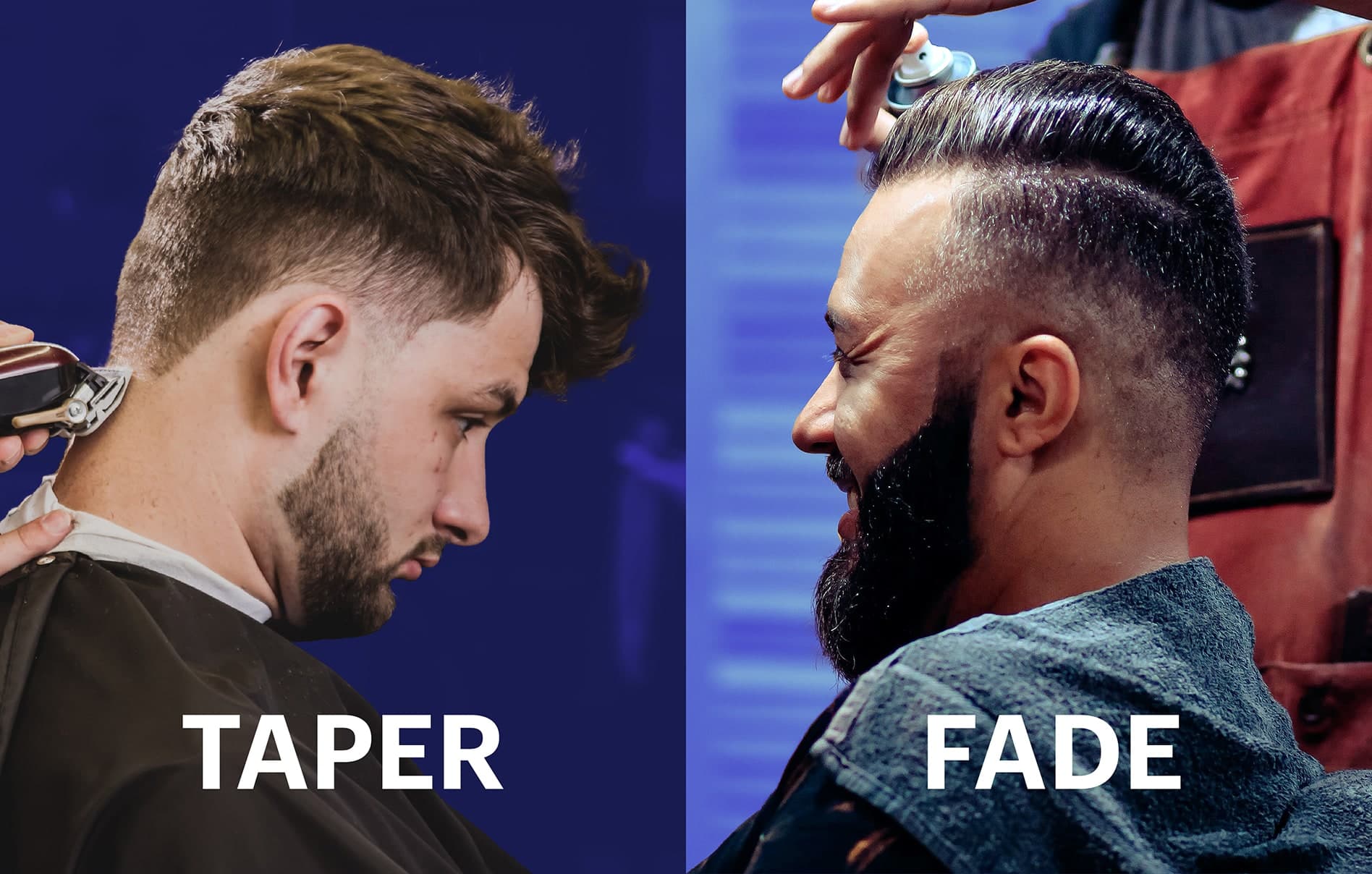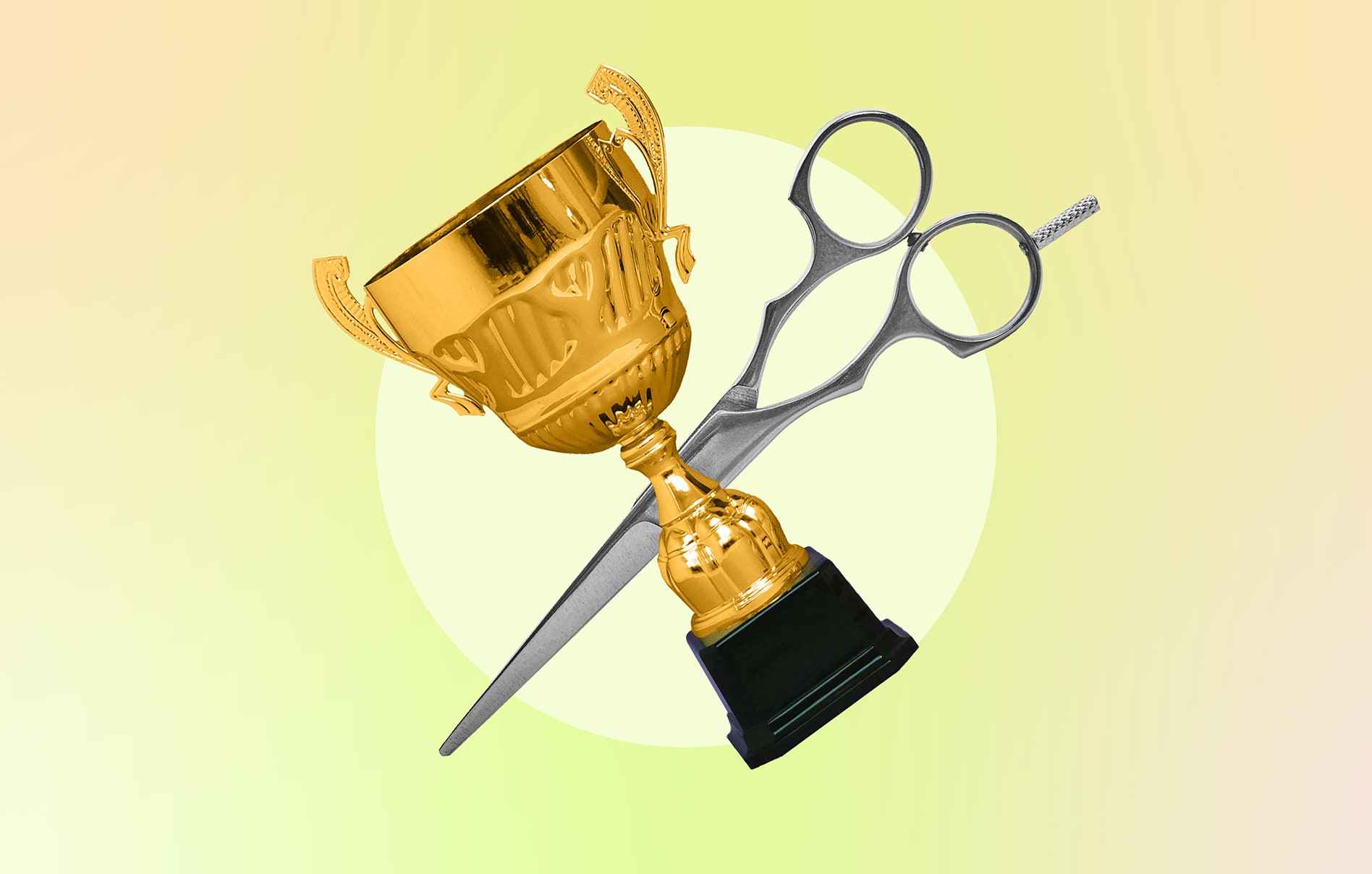Tapered look? Or fade? And what’s the difference anyway?
The taper and fade haircuts are timeless, classic looks for men.
While these styles seem similar at first glance, they have distinct differences that can drastically affect your final look.
Let’s talk through the basics of the taper and fade haircuts to help you choose the look for you.
In this blog:
- Taper vs fade haircuts
- Different types of fades
- The ideal haircut for your face shape
- Maintenance and styling tips
Key Differences Between Taper and Fade Haircuts
While taper and fade haircuts share a few similarities, they differ in their specific techniques and end results.
Deciding between the two before your barber appointment can be tough, but understanding their differences can help you make an informed decision.
| Taper Haircut | Fade Haircut |
| A taper haircut gradually decreases in hair length from the top of the head to the neckline. The gradual transition prevents harsh lines and creates a natural/blended look. Tapered haircuts come in different lengths and styles and are versatile for most hair types. | A fade haircut involves fading the length of the hair from the top of the head down to the sides and nape of the neck. The fade can either blend gradually or sharply from long to short. Fades require a skilled barber with the right tools to execute correctly. |
| Taper haircuts work well for people with a variety of hair types, textures, and personal styles. They are also low maintenance and provide great flexibility in styling. | Fade haircuts look great on people with a defined bone structure, such as chiseled cheekbones or a strong jawline. They require regular upkeep to maintain the sharp lines and pristine look. |
When deciding between a taper or a fade haircut, it’s important to consider:
- Your hair type
- Your face shape
- Your lifestyle…
Do you prefer a low-maintenance cut? Go with a taper.
Are you willing to invest time and effort into keeping it looking sharp? Book a fade.
No matter which cut you choose, both taper and fade styles offer a modern, sleek look that can easily be tailored to your personal preferences.
What is a Taper Haircut?
A taper haircut is a popular and versatile hairstyle that gradually shortens the hair from the top to the neckline.
The resulting look is a smooth and blended transition with no sharp lines.
Tapered haircuts can be adjusted to various lengths and styles, but the timelessness of a taper haircut lies in its simplicity.
It’s a low-maintenance style that requires very little product and care. It’s a great option if you want to look stylish without too much fuss.
What is a Fade Haircut?
A fade is a popular haircut that features gradually shorter hair from the temple and sides, blending into a shorter length at the back and neckline.
The transition between the longer hair on top and the shorter hair at the sides and back creates a faded effect. Clever, huh? 😉
It works well with short to medium-length hair, but fades are a versatile cut that can be styled to suit different face shapes and hair types.
Unlike a taper, maintaining a fade involves regular appointments to the barbershop to keep the cut looking sharp.
Keep in mind: Trims are recommended every 2-4 weeks.
The best thing about a fade haircut is that it can be customized.
You can choose the level of fade you want, from a low fade to a high fade.
You can also use styling products, such as pomade or wax, to create various textures and finishes, ranging from a natural, messy look to a sleek sophisticated style.
Understanding the Different Types of Fades
When it comes to fades, there are a few types of cuts to choose from. Here are the most common types of fades:
- Low Fade: This type of fade starts above the ear and gradually tapers down to the neckline.
- Mid to High Fade: A high fade starts at the temple and gradually tapers down towards the back of the head, creating a more dramatic contrast. (These are great cuts for men dealing with hair loss, too!)
- Taper Fade: A taper fade blends the hair seamlessly to create a natural-looking fade.
- Skin Fade: Also known as a bald fade, a skin fade is a more extreme version of a taper fade, where the hair is faded down to the skin.
Your Face Shape and the Ideal Haircut
Have you ever wondered why a particular haircut looks great on some people but not on others?
The key lies in matching your haircut to your face shape.
Some haircuts are more flattering for your features than others.
Find out your face shape and learn which haircut will look best on you:
| Face Shape | Ideal Haircut | Description |
| Oval | Taper or Fade | An oval face shape is the most proportional, with balanced features. As a result, you can experiment with different hairstyles, including taper and fade haircuts. Both styles help maintain your face’s natural balance and highlight your unique facial features. |
| Square | Taper | A square face shape has a strong jawline with a wide forehead and cheekbones. Taper haircuts soften the sharp edges of your face by creating a natural-looking flow and balance. Avoid extremes in hair length or width at the sideburns. |
| Round | Fade | A round face shape has a soft, rounded jawline with a wide cheekbone, forehead, and chin. A high or mid-fade adds texture and depth to your hair without accentuating the roundness of your face. |
| Heart | Taper | A heart-shaped face has a broad forehead and narrow chin. Tapers complement your face structure by balancing the volume between the top and bottom. A slight taper around the forehead can create a softer hairline that complements the widow’s peak. |
| Diamond | Fade | A diamond face shape has a broad forehead and narrow chin but with an angular jawline. A fade haircut highlights the sharpness of your jawline and creates a contrast with the haircut’s volume on top. |
| Rectangle | Taper or Fade | A rectangular face shape has a long, narrow structure with straight cheek lines. Both fade and taper cuts work well with your face shape. They add either texture on top (with a tapered cut) or contrast between the sides and top (with a fade haircut), balancing your face. |
Maintenance and Styling Tips for Tapers
Keeping a taper haircut looking sharp requires regular low maintenance.
Maintenance
- Schedule regular appointments with your barber to maintain the length and shape of your taper.
- Wash your hair every two to three days to prevent dirt and excessive oil build-up using a lightweight shampoo. (Heavy formulas can weigh your hair down and affect the taper’s shape.)
- Use lukewarm water when rinsing your hair to avoid drying out your scalp and hair.
- Apply a lightweight conditioner to the ends to keep your hair moisturized.
- Use a wide-tooth comb or your fingers to detangle your hair gently.
- Let your hair air-dry.
- Trim your sideburns frequently to keep your taper looking neat.
Styling
Styling a taper is simple and effortless.
- Dry your hair with a towel, gently patting without rubbing.
- Apply a small amount of styling cream or pomade to your hands, rubbing them together before running them through your hair. This smooths out any frizz and adds texture to your taper.
- Use your fingertips to style your hair into shape. Start with the top of your hair, moving to the sides, and finishing with the back. Use a comb or hairbrush to add volume, as needed.
- To maintain your taper’s shape, use a hairspray with a light flexible hold.
Caring for Fades: Maintenance Advice
Keeping your fade haircut looking clean and crisp requires regular maintenance.
- Schedule regular haircuts every two to four weeks to maintain the clean-cut look of your fade.
- Avoid washing your hair every day. (This can dry out your scalp and cause damage to your hair.) Instead, wash your hair two to three times a week with a mild shampoo and conditioner.
- After washing, gently towel dry your hair without rubbing it vigorously to prevent frizz. Apply leave-in conditioner or hair oil to keep your hair moisturized and healthy.
- Use a wide-tooth comb to detangle your hair, starting from the ends and moving upwards, and prevent breakage and minimize damage to the hair cuticle.
Deciding Between a Taper and a Fade: What to Consider
Choosing between a taper and a fade haircut can be challenging.
Before booking your appointment at a barber shop, consider this:
Personal Style
Your personal style plays a significant role in deciding between a taper and a fade haircut.
If you prefer a classic, almost-military look, a fade haircut may be right for you.
If you like to show off your individuality, styling a taper haircut could be fun!
Hair Texture and Length
Your hair texture is another crucial factor when deciding between a taper and a fade haircut.
If you have thick, dense hair, a fade haircut may be better suited, as it removes bulk and eliminates weight from the sides.
A taper haircut is ideal for those with finer or thinner hair, as it creates a more natural, balanced look.
Lifestyle
A taper haircut requires less maintenance and styling time, making it more suitable for individuals who prefer a low-maintenance hairstyle.
A fade haircut requires more frequent trims to maintain its clean look and may require more maintenance and styling for those who want to keep it looking sharp.
Face Shape
Your face shape can also help determine which haircut is ideal for you.
If you don’t know your face shape, go with taper haircuts. It works well with most face shapes, as they create a natural, balanced look.
Conclusion
Both hair styles are trendy and versatile, making them a great choice for anyone walking into a barbershop.
Consider your face shape, hair type, and lifestyle when choosing between a taper or fade – and don’t forget about the hair maintenance and styling!






